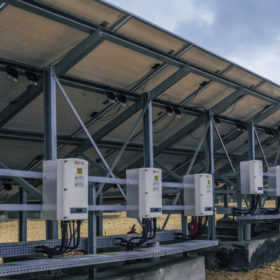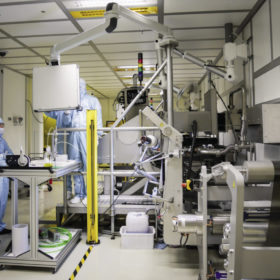Single‐walled carbon nanotubes for more efficient III‐V solar cells
Russian researchers have improved the efficiency of a thin-fim GaAs‐based solar cell by 0.9% by applying single‐walled carbon nanotubes as the topmost layer. The cell also showed a slight increase in the short circuit current density, from 16.9 to 17.9 mA/cm2.
‘Free-form’ organic PV
French organic PV module manufacturer Armor said it began manufacturing free-form PV modules in early April. The new technology will allow the company’s ASCA PV film to be produced in a range of different shapes.
The long read: More or less
How much granularity in monitoring and optimization is enough? Module-level power electronics have been a popular addition to the residential segment and, for several reasons, have enjoyed growing popularity on commercial rooftops. But where is the limit? While there are the first ground-mount installations with MLPE, other companies suggest that less is more and scaled down their optimization and monitoring granularity.
Global supergrid vs. regional supergrids
Researchers from Finland’s Lappeenranta University of Technology have assessed the economic advantages of a fully interconnected global network. They found that an international grid could contribute to a global LCOE of €52.50/MWh. The higher complexity of such a system, however, would only be marginally compensated by additional economic benefits.
MNRE to host Global RE-Invest 2020 digitally
Given Covid-19 spread, India’s ministry has decided to conduct the third Global Renewable Energy Investors Meet and exposition (3rd RE-Invest)—scheduled from October 15 to 17—on a digital platform. The ministry has sought proposals for an interactive IT platform to facilitate the same.
Vibration tech for self-cleaning solar panels
Scientists in the U.K. have developed a system which makes panels vibrate to provide cleaning. The academics have conceded, however, they are yet to calculate the ‘sweet spot’ of mechanical stress to be applied.
Solar inverters vs. cyberattacks
A U.S. research group is now developing new inverters to protect solar installations from cyberattacks. The researchers also aim to create new cybersecurity standards. Professor Alan Mantooth, the group’s research coordinator, said that inverters can be shut down if they are hacked, or contribute to grid instability and result in the overcharging of batteries, while potentially creating problems that we still don’t know how to address.
The long read: 2020 is the decade of perovskite PV
About 10 years ago, perovskite solar cells (PSCs) made their entry into the world of PV with a power conversion efficiency of 3.8%. Fast forward to 2020, and PSCs are the talk of the town, with a string of impressive laboratory achievements to their name. Global research efforts have shifted toward PSCs as efficiencies keep on getting thrashed on a regular basis. But is it too soon to say that the technology is ready for commercialization?
A non-flammable lithium metal battery
Researchers from Deakin University in Australia claim their battery chemistry is based on a new class of electrolyte material which carries no risk of uncontrolled thermal events and represents a viable alternative to rechargeable lithium-ion batteries.
Global solar EPC market dominated by US, German, Indian contractors
Although the Wiki-Solar website ranking only provides a snapshot of PV project engineering, procurement and construction contracts outside of China, it is nevertheless a useful indicator of the changing global solar market landscape. Of the top 11 companies, four are based in India, three in Germany, and two in the United States. But last year’s largest contractor, U.S.-based First Solar, might lose its leading position this year, as it has largely discontinued its EPC activities.















